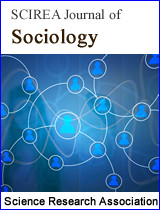Sacredness of Dayak Ribun Forest: Knowledge, Livelihood and Belief
DOI: 10.54647/sociology84620 94 Downloads 12702 Views
Author(s)
Abstract
This study aims to describe the knowledge system of the Ribun Dayak tribe about their forest in West Kalimantan. The knowledge system of the Dayak Ribun community consists of knowledge of the community, knowledge of sources of livelihood, and knowledge of belief/religion. The research subjects were the Dayak Ribun tribe in Parindu District, Sanggau Regency, West Kalimantan. The approach used in this research is an ethnographic approach. Data collection uses direct observation techniques, in- depth interviews, and documentation studies. Based on the results of this study, it can be explained that the Ribun Dayak tribe has a unique knowledge system; First, knowledge of farming based on natural phenomena. Second, knowledge in the livelihood/livelihood system through shifting cultivation. Third, knowledge of belief systems and religion, even though they have embraced Catholicism and Protestantism, but they have not abandoned the belief system of traditions, customs, and customary law which still functions as social control.
Keywords
Knowledge System, Dayak Ribun, Ethnography
Cite this paper
Arkanudin, Mashudi, E. Sutandar,
Sacredness of Dayak Ribun Forest: Knowledge, Livelihood and Belief
, SCIREA Journal of Sociology.
Volume 5, Issue 5, October 2021 | PP. 277-287.
10.54647/sociology84620
References
| [ 1 ] | Arkanudin. (2011). Sebuah Penelitian Antropologi Perubahan Sosial Masyarakat Peladang Berpindah. Pontianak: STAIN Press. |
| [ 2 ] | Arkanudin, Rupita., & Zahriadi. (2007). Resolusi Konflik Pertanahan Berdasarkan Pranata Adat: Studi Pada Etnik Dayak Ribun yang Berada di Sekitar PIR-Bun Kelapa Sawit Parindu, Sanggau, Kalimantan Barat. Pontianak: Fakultas Ilmu Sosial dan Ilmu Politik Universitas Tanjungpura. |
| [ 3 ] | Asfar, D. aA. (2004). Sastra Lisan Iban Sungai Rimbas Sarawak: Perspektif Etnopuitika. Tesis Universiti Kebangsaan Malaysia. |
| [ 4 ] | Asfar, D. A. (2017). Diftongisasi dalam Bahasa Ribun. Tuah Talino: Jurnal Bahasa dan Sastra. 11(1): Doi: https://doi.org/10.26499/tt.v11i1.1046 |
| [ 5 ] | Crevello, S. M. (2003). Local Land Use on Borneo: Applications of Indigenous Knowledge System and Natural Resource Utilization Anong the Benuaq Dayak of Kalimantan, Indonesia. Doctoral Dissertations: Louisiana State University and Agricultural and Mechanical College. |
| [ 6 ] | Darmadi, H. (2016). Dayak Asal Usul dan Penyebarannya di Bumi Borneo. Sosial Horizon: Jurnal Pendidikan Sosial. 3(2):322-340. |
| [ 7 ] | Istiyani, C. P. (2008). Peta Keberagaman Subsuku Dayak di Kalimantan Barat. Pontianak: Institut Dayakologi. |
| [ 8 ] | Kim, S. H. (1993). Identifying alternative linkages among philosophy, theory and method in nursing science. Journal of Advanced Nursing. 18, 793-800. |
| [ 9 ] | Koentjaraningrat. (1992). Manusia dan Kebudayaan di Indonesia. Jakarta: Djembatan. |
| [ 10 ] | Koeswinarno. (2015). Memahami Etnografi ala Spradley. Jurnal SMaRT. 1(2):257-265. |
| [ 11 ] | Mona. (2003). Onok Adak Onok Nusantara. Dalam Kumpulan Diskusi dan Presentasi KEDAI (Kelompok Diskusi Adat Indonesia). Jakarta: International Centre for Research in Agroforestry. |
| [ 12 ] | Mudiyono. (1995). Perubahan Sosial dan Ekologi Peladang Berpindah, Pontianak: Dalam Suara Almamater Universitas Tanjungpura, No II Tahun V Nopember 1990. |
| [ 13 ] | Mulyoutami, E., Rismawan, R., & Joshi, L. (2009). Local knowledge and management of simpukng (forest gardens) among the Dayak people in East Kalimantan, Indonesia. Forest Ecology and Management. 257, 2054-2061. Doi:10.1016/j.foreco.2009.01.042 |
| [ 14 ] | Niko, N. (2016). Perempuan Dayak Benawan: Kedudukan Pada Struktur Domestik & Publik. Yogyakarta: Deepublish. |
| [ 15 ] | Niko, N. (2020). Gender Struggle: What Can We Learn from the Dayak Benawan Women?. Walailak Journal of Social Science. 13(2):269-292. Retrieved from https://so06.tci-thaijo.org/index.php/wjss/article/view/234156 |
| [ 16 ] | Perda Kabupaten Sanggau Nomor 1 Tahun 2017 Tentang Pengakuan dan Perlindungan Masyarakat Hukum Adat. Retrieved from: https://peraturan.bpk.go.id/Home/Details/54925/perda-kab-sanggau-no-1-tahun-2017 |
| [ 17 ] | Sapardi. (1991). Pengaruh Perkebunan Inti Rakyat Terhadap Rumah Tangga Petani di Kecamatan Parindu, Tesis, Program Pascasarjana Universitas Indonesia. |
| [ 18 ] | Spradley, James. P. 1980. Participant Observation. United State of America: Holt, Ronehart and Winston. |
| [ 19 ] | Sunker, A., Saraswati, A., & Santosa, Y. (2019). Indigenous Dayak People’s Perceptions of Wildlife Loss and Gain Related to Oil Palm Development. International Journal of Environmental and Ecological Engineering. 13(2):37-42. Doi: doi.org/10.5281/zenodo.2571883 |
| [ 20 ] | Suwarno. (2017). Budaya Huma Betang Masyarakat Dayak Kalimantan Tengah dalam Globalisasi: Telaah Konstruksi Sosial. Lingua. 14(1):89-102. |
| [ 21 ] | White, B. (2009). Dibalik pertarungan sumber daya alam Indonesia: ekologi politik dan penerapannya pada studi dan perjuangan lingkungan hidup. Tanah Air. Edisi: Oktober-Desember, 3-9. |

